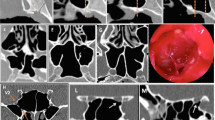Abstract
The aim of this study was to evaluate sphenoid sinus pneumatisation and its anatomical relation with adjacent neurovascular structures in Indian population. We performed a retrospective cross-sectional study, in which the pattern of sphenoid sinus pneumatization was studied on high-resolution computed tomography scans (n = 400), and association of the optic nerve, vidian canal and foramen rotundum along with related morphometric measurements were studied. Out of 400 CT scans, 60.5% were males. Majority had sellar type of pneumatization (89.5%) and single intersinus septum (68%). The most common configuration of relation of optic nerve canal was DeLano type 2 (34.75%). Vidian canal (VC) and Foramen rotundum (FR) were found dehiscent in 40.5% and 6.38% respectively. Average distance of FR from midline on right and left side was 16.3 ± 2.19 mm and 16.7 ± 2.23 mm respectively. Average distance of VC from midline on right and left side was 12.4 ± 5.84 mm and 12.4 ± 4.18 mm respectively. Average right FR to VC distance was 4.17 ± 2.16 mm and left FR to VC was 4.44 ± 2.20 mm. Anatomical variations of the sphenoid sinus are well known. In the present study, we have tried to highlight the importance of knowledge of various anatomical variations in relations to sphenoid sinus as they are critical in planning of surgery. Pre-operative radiological study and correlation is inevitable to assess type and extent of sinus pneumatisation, bony dehiscence and septal terminations to avoid injury to vital structures.






Similar content being viewed by others

References
Hammer G, Rådberg C (1961) The sphenoidal sinus: an anatomical and roentgenologic study with reference to transsphenoid hypophysectomy. Acta radiol 56(6):401–422
DeLano MC, Fun FY, Zinreich SJ (1996) Relationship of the optic nerve to the posterior paranasal sinuses: a CT anatomic study. Am J Neuroradiol 17(4):669–675
Vaezi A, Cardenas E, Pinheiro-Neto C, Paluzzi A, Branstetter BF, Gardner PA et al (2015) Classification of sphenoid sinus pneumatization: relevance for endoscopic skull base surgery. Laryngoscope 125(3):577–581
Tan HKK, Ong YK (2007) Sphenoid sinus: an anatomic and endoscopic study in Asian cadavers. Clin Anat 20(7):745–750
Daniels DL, Mark LP, Ulmer JL, Mafee MF, McDaniel J, Shah NC et al (1998) Osseous anatomy of the pterygopalatine fossa. Am J Neuroradiol 19(8):1423–1432
Madiha AESRA (2007) Endoscopic anantomy of sphenoidal air sinus. Bull Alex Fac Med 43:1021–1026
Lee SK, Park YS, Cho JH, Park YJ, Kang JM, Jeon EJ et al (2004) Anatomic variations of sphenoid sinus and related neurovascular structures: a Study of CT Analysis. Korean J Otorhinolaryngol-Head Neck Surg 47(10):978–982
Cho JH, Kim JK, Lee JG, Yoon JH (2010) Sphenoid sinus pneumatization and its relation to bulging of surrounding neurovascular structures. Ann Otol Rhinol Laryngol 119(9):646–650
Unal B, Bademci G, Bilgili YK, Batay F, Avci E (2006) Risky anatomic variations of sphenoid sinus for surgery. Surg Radiol Anat 28(2):195–201
Cappabianca P, Cavallo LM, Esposito F, de Divitiis O, Messina A, de Divitiis E (2008) Extended endoscopic endonasal approach to the midline skull base : the evolving role of transsphenoidal surgery. Adv Tech Stand Neurosurg 33:151–199
Heskova G, Mellova Y, Holomanova A, Vybohova D, Kunertova L, Marcekova M et al (2009) Assessment of the relation of the optic nerve to the posterior ethmoid and sphenoid sinuses by computed tomography. Biomed Pap 153(2):149–152
Itagi RM, Adiga CP, Kalenahalli K, Goolahally L, Gyanchandani M (2017) Optic nerve canal relation to posterior paranasal sinuses in indian ethnics: review and objective classification. J Clin Diagnostic Res 11(4):01–3
Hewaidi G, Omami G (2008) Anatomic variation of sphenoid sinus and related structures in libyan population: CT scan study. Libyan J Med 3(3):128–133
Nitinavakarn B, Thanaviratananich S, Sangsilp N (2005) Anatomical variations of the lateral nasal wall and paranasal sinuses: a CT study for endoscopic sinus surgery (ESS) in Thai patients. J Med Assoc Thai 88(6):763–768
Davoodi M, Saki N, Saki G, Rahim F (2009) Anatomical variations of neurovascular structures adjacent sphenoid sinus by using CT scan. Pak J Biol Sci PJBS 12(6):522–525
Priyadarshini D, Prabhu LV, Kumar A, Pai MM, Dananjay KVN (2015) The anatomical variations in the neurovascular relations of the sphenoid sinus: an evaluation by coronal computed tomography. Turk Neurosurg 25(2):289–293
Chong VF, Fan YF, Lau DP, Chee LW, Nguyen TM, Sethi DS (2000) Imaging the sphenoid sinus: pictorial essay. Australas Radiol 44(2):143–154
Asirdizer M, Tatlisumak E, Bora A, Tarhan S, Yilmaz Ovali G, Hekimoglu Y et al (2017) The possible effects of altitude and climate on the development of the frontal sinus in adults. Int J Morphol 35(2):571–577
Guglielmino-Matessi CR, Gluckman P, Cavalli-Sforza LL (1979) Climate and the evolution of skull metrics in man. Am J Phys Anthropol 50(4):549–564
Mohebbi A, Rajaeih S, Safdarian M, Omidian P (2017) Seio esfenoidal, forame redondo e canal pterigoideo: estudo radiológico das relações anatômicas. Braz J Otorhinolaryngol 83(4):381–387
Awadalla AM, Hussein Y, Elkammash TH (2015) Anatomical and radiological parameters of the sphenoid sinus among egyptians and its impact on sellar region surgery diagnostic radiology, faculty of medicine. Suez Canal Univ Egypt J Neurosurg 30(1):1–12
Kasemsiri P, Solares CA, Carrau RL, Prosser JD, Prevedello DM, Otto BA et al (2013) Endoscopic endonasal transpterygoid approaches: anatomical landmarks for planning the surgical corridor. Laryngoscope 123(4):811–815
Yazar F, Cankal F, Haholu A, Kiliç C, Tekdemir I (2007) CT evaluation of the vidian canal localization. Clin Anat 20(7):751–754
Funding
This research did not receive any specific grant from funding agencies in the public, commercial, or not-for-profit sectors.
Author information
Authors and Affiliations
Corresponding author
Ethics declarations
Conflict of interest
The authors declare that they have no conflict of interest.
Additional information
Publisher's Note
Springer Nature remains neutral with regard to jurisdictional claims in published maps and institutional affiliations.
Rights and permissions
About this article
Cite this article
Thakur, P., Potluri, P., Kumar, A. et al. Sphenoid Sinus and Related Neurovascular Structures—Anatomical Relations and Variations on Radiology—A Retrospective Study. Indian J Otolaryngol Head Neck Surg 73, 431–436 (2021). https://doi.org/10.1007/s12070-020-01966-y
Received:
Accepted:
Published:
Issue Date:
DOI: https://doi.org/10.1007/s12070-020-01966-y



